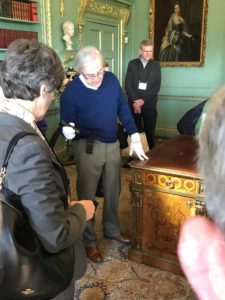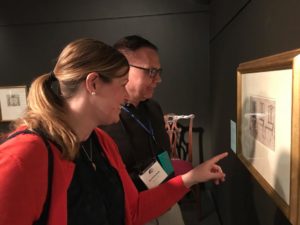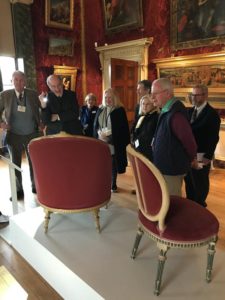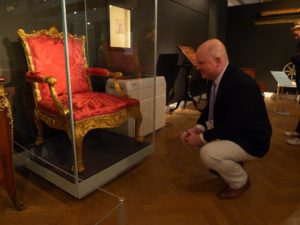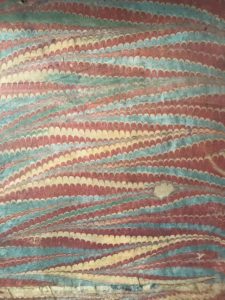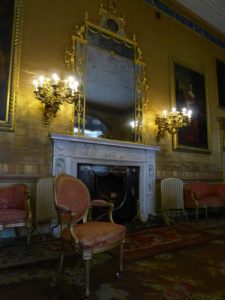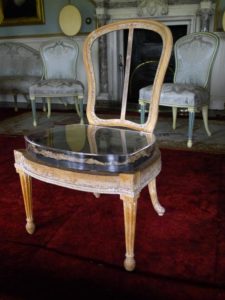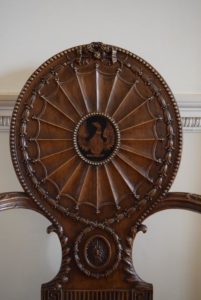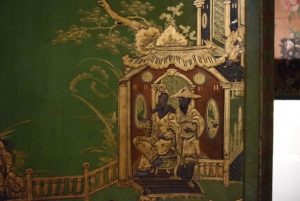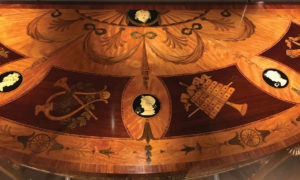Review: Celebrating Chippendale’s Tercentenary
EVENTS > STUDY TRIPS ABROAD
STUDY TRIP ABROAD SPRING 2018 IN REVIEW
In honor of the 300th anniversary of Thomas Chippendale’s birth, an enthusiastic band of furniture devotees ventured to Great Britain in April to enjoy a stunning array of sites and exhibitions dedicated to the talented English furniture designer. Over the course of seven days, our members encountered a remarkable percentage of the extant wares documented to Chippendale’s shop, representing the full range of his oeuvre, from Rococo to Neoclassical and beyond.
The eager participation of leading Chippendale scholars and the hospitality of our private hosts elevated this program to new heights. We were accompanied in Yorkshire by Adam Bowett and James Lomax, the curators and authors behind the major exhibition and catalogue developed for the tercentenary celebration. While the show at the Leeds City Museum was modestly scaled relative to recent American monographic projects on John Townsend, Duncan Phyfe, and John and Thomas Seymour, the material was comprehensive, first rate, and provided a tremendous overview of the material we encountered during the trip. Most importantly, the exhibit attracted interest from the general public, and we appreciated the concerted effort to recognize Chippendale as a master of English craftsmanship and design.
Although the itinerary brought us back to the signature houses of the 2016 Study Trip Abroad to Yorkshire, even our repeat participants delighted in the opportunity to reevaluate the collections at Temple Newsam, Nostell Priory, Newby Hall, and Harewood House with fresh eyes. Many of these houses mounted special installations in honor of the tricentennial or reinstalled portions of the collection for 2018. Members were also fortunate to see the holdings at privately owned Scampston, Birdsall, and Aske Hall, a Dundas family house that was not included in 2016. The variety of Chippendale’s output, from japanned case furniture and elaborate gilt mirrors to painted chairs and exuberantly inlaid table tops and case pieces, did not fail to impress.
During our brief conclusion in Scotland, David Jones led explorations of Paxton House and Dumfries House that highlighted the breadth of Chippendale’s shop production for his Scottish clients. At the former, his products in the neat and plain style are on full display, offering strong connections to 18th-century furniture preferred by colonists in the American south. Mr. Jones organized an exhibition and catalogue in collaboration with Paxton House Curator Fiona Salvesen Murrell to promote the extent of their holdings tied to Chippendale and his eldest son and namesake, who took over the business in the 1770s.
Through our immersive “Chip Trip,” we gained a comprehensive understanding of the discoveries brought forward by recent research as well as the mysteries that continue to surround Chippendale. Even though he stands as the most famous name in furniture design history and was recognized as an important figure in his day, few details of his personal life survive. Born in 1718 and reared in a woodworking family in the quaint Yorkshire market town of Otley, Chippendale’s whereabouts prior to his arrival in London shortly before the 1754 publication of his influential Gentleman and Cabinet-Maker’s Director are undocumented. Only through circumstantial evidence is he tied to York prior to his meteoric rise.
Furthermore, while the significance of Chippendale’s Scottish business partners cannot be understated, the exact source of his connection to financiers in the north is not documented. Chippendale’s initial partner, James Rannie, and bookkeeper, Thomas Haig, were business savvy Scotsmen who oversaw the financial aspects of the cabinetmaking enterprise. Mr. Jones also reported that a surprising percentage of subscribers to the Director were Scots, including a handful of members of the Royal and Ancient Golf Club of St. Andrew’s.
In addition to the extraordinary variety of objects and architecture encountered on tour, the expedition significantly benefited from the participation of two scholarship recipients, Alyce Perry Englund and Adam Erby. Young curators at the Metropolitan Museum of Art and Mount Vernon, respectively, they are directly tied to projects focused on 18th-century British furniture. For Ms. Englund, who recently opened an exhibition on Chippendale, the Study Trip “greatly enhanced my curatorial preparations” for the show. Mr. Erby is studying a suite of furniture ordered by George Washington’s neighbors, George and Sally Fairfax, from London upholster William Gomm. These wares ultimately resided at Mount Vernon, and Mr. Erby “could not have imagined a more insightful experience” than provided by the Trust. Likewise, they offered edification to our fortunate attendees.

